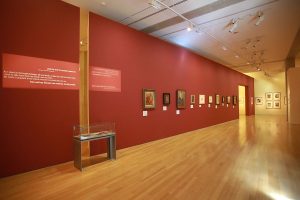Who Will Write Our History?
At the entrance to the Yad Vashem Art Museum are inscribed the following words: “As I stand on the border between life and death, certain that I will not remain alive, I wish to take leave from my friends and my works…. My works I bequeath to the Jewish museum to be built after the war. Farewell, my friends. Farewell, the Jewish people. Never again allow such a catastrophe.” These words were written in the last will and testament of the Polish-Jewish artist, Gela Seksztajn (1907-1943).
Seksztajn and her husband, Dr. Izrael Lichtensztajn (1904-1943), were among the group of people who documented conditions in the Warsaw Ghetto under the leadership of Dr. Emanuel Ringleblum, and known by their code name: “Oyneg Shabbos.” The group would hold their secret meetings on the Sabbath, hence the name. The documentation consisted of journals, ephemera of all kinds, reports on conditions in the ghetto, and art work. All of the collection and preservation of the material was done, of course, at mortal risk to the participants, living in the closed Warsaw Ghetto since 1940, in conditions of terrible overcrowding, squalor and hunger. During the summer of 1942 there was a massive deportation from the Ghetto, which included some members of Oyneg Shabbos. After these mass deportations, all illusions about the possibility of long-term survival vanished. Bitter awareness spawned greater urgency – and greater readiness – to resist the Nazis. This in turn led to the burying of the archive in three caches: the first was buried in metal boxes in August 1942, the second in milk cans in February 1943, and the third in April 1943, right before the Uprising. Dr Lichtensztajn was in charge of choosing the locations and burying the material. Besides him, only two people knew the locations. The Uprising, which began on April 19, 1943 was remarkable on two counts: first of all, it was the first armed uprising by anyone – Jew or non-Jew – in all of occupied Europe. In contrast, the Polish uprising occurred only in August 1944, when the Allies were already squeezing Hitler on both the eastern and western fronts. Secondly, the rag-tag group of a mere 700 to 750 Jewish resistance fighters managed to hold off the Nazis for 27 days, without any outside assistance. Ultimately, the Nazis retook the Ghetto by razing it to the ground, and only a few of the remaining 50,000 Jews of the ghetto escaped deportation or survived the death camps. After the war, only two of the buried caches were found and their contents are preserved in Warsaw in the archive of the Jewish Historical Institute. This remarkable archive furnished the raw material for the new documentary by Roberta Grossman and Nancy Spielberg, Who Will Write Our History? The title is taken from a book by Samuel Kassow, an academic work devoted solely to the history of Oyneg Shabbos. The movie was screened around the world on January 27, International Holocaust Remembrance Day. The film is a combination of documentary and reconstruction—using actors in real settings in Europe, with dialogue in Yiddish. The texts are all from the archive, some of which were translated into English for the first time.

What of the art of the Warsaw Ghetto? So few things have survived. One work of Seksztajn’s’s may be seen here in Jerusalem—a pre-war work given by her to a family member, now on loan to the Yad Vashem Art Museum [Fig. 1].
The Painter and the Hassid
A remarkable contemporary series by Ruth Kestenbaum Ben-Dov, The Painter and the Hassid, deals with one of the Ghetto residents not mentioned in the film, the Rabbi from Piaczezna, Kalonymus Kalman Shapira (1889-1942), whose work was also preserved in the Oyneg Shabbos archive. Shapira is best known for the book of the Sabbath sermons that he gave in the Warsaw Ghetto, published after the war as Holy Fire, אש קודש. It is not clear who gave this material to Oyneg Shabbos, but in addition to Shapira’s sermons, many of his unpublished pre-war book manuscripts were deposited in the milk cans as well. Shapira and an artist that perished in Theresienstadt, Malva Schalek (1882-1944), are the subjects of this series, along with Kestenbaum Ben-Dov herself. Shapira and Schalek’s legacy lives on because their work was hidden and discovered after the war as portrayed in Hidden 2, [Fig. 2] painted in 2009. At the upper portion of the work, one can seen some of the drawings hidden by Schalek, including self-portraits. At the bottom of the work, one can see the milk can containing one of the Rabbi’s texts, from which light emanates.

Other works also incorporate images of the Rabbi’s original texts in his own handwriting, including, Now the Sorrow is So Great that the World Cannot Contain It. Some of the series depicts encounters between the artist and her subjects. Shapira’s teachings continue to inspire in the many classes taught about him. An annotated volume of his writings was recently published by the Herzog College (in Hebrew).
The legacy of the Warsaw Ghetto Uprising is still strongly felt in Israel. While International Holocaust Remembrance Day was only established in 2005, as the day the Red Army liberated Auschwitz in 1945, Israel’s Holocaust Remembrance Day, initiated already in 1951, is linked to the day the uprising began, the eve of Passover. Dr. Izrael Lichtensztajn’s hope, stated in his will, that his wife will be remembered, has been fulfilled, not only because the boxes with her art work were among the first discovered in 1946. Due to his heroic efforts and the efforts now of Roberta Grossman and Nancy Spielberg, their remarkable story will be told and remembered anew.
